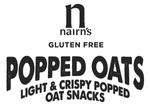KP takes a pop
This partial victory suggests the power of reputation, writes David Birchall.

In 2018, KP Snacks Ltd (KP) opposed applications by Nairn’s Oatcakes Ltd (Nairn’s) to register both “POP OATS/Pop Oats” as a series (the Word Application) and a composite mark (the Composite Application) as UK trade marks. Both applications covered goods in class 30, including “preparations made from cereals; snacks, snack foods, crisps made of cereal”.

KP opposed both applications under s5(2)(b) and s5(3) of the Trade Marks Act 1994 (TMA), based on its EU trade mark (EUTM) for POPCHIPS and its EU designation of a stylised version, both protected for class 29 “potato-based snack foods; vegetable-based snack foods” and class 30 “corn-based snack foods, excluding breakfast cereals and cereal bars”.
Following Nairn’s request that KP prove use of its EUTM, it was held that KP had proven use on those class 29 goods.
Unregistered rights claim
KP also opposed the applications under s5(4) TMA, claiming unregistered rights in both of its marks as a result of use throughout the UK since March 2012 in relation to snacks, snack foods, potato-based snack foods, vegetable-based snack foods and corn-based snack foods. KP asserted that its marks had acquired a significant reputation in the EU, including the UK, and cited UK sales in major supermarkets including Tesco, Sainsbury’s, Asda and Waitrose, as well as outlets such as Ocado and Starbucks. It also pointed to various endorsements and promotions. KP claimed that consumers would assume that goods sold under the opposed marks originated from KP either directly or under licence, that Nairn’s use would free-ride on KP’s reputation, and that use on inferior goods would be detrimental to KP’s reputation.
Nairn’s filed evidence showing the number of registered UK trade marks and EUTMs incorporating the word POP or POPPED in classes 29 and 30 and the results of internet searches for “pop/popped” and “snack”, and “popped” and “foods”, which showed a range of snack and food products featuring the words “pop” or “popped” on the product packaging or in a description. Nairn’s also exhibited pages of KP’s website showing the words “pop” and “popped” used by KP to describe its product and the method used to cook the potatoes.
The Hearing Officer (HO) found that the words “pop” and “chips” are common, easily understood words in the English language and that, in the context of potato crisps that are popped with heat and pressure, POP and POPCHIPS are weak in distinctiveness. The HO commented that, when comparing marks, any level of descriptiveness of the common elements should be borne in mind.
In relation to the Composite Application, the HO found that in the context of goods that could be made from or contain oats, “popped oats” would be seen as referring to an ingredient of the products (oats) and the way that ingredient is prepared (popped). The HO found that the Composite Application comprised much more than simply the sole shared element “pop”, and that the impact of the other elements – such as NAIRN’S, which would be pronounced – could not be discounted. The HO found that the coincidence of the element “pop” is not particularly noticeable in the overall impression of the composite mark – for example, it does not have an independent distinctive role and does not dominate the overall impression created by the mark – and that any similarity would therefore be very low indeed.
Assessing the Word Application, the HO commented that the average consumer knows that the word “pop” is weak in distinctiveness and found any similarity with KP’s marks low. The HO then found that the use shown did not significantly enhance any likelihood of confusion and found the Composite Application easily distinguishable. She found that the average consumer would not reduce the Composite Application down to “popped oats” and that the differences are not consistent with a brand extension. The HO held that the average consumer is aware that “pop” is a term that alludes to a method of cooking with air, a meaning about which KP’s marketing had educated consumers. The HO found that there was no risk of confusion between KP’s marks and either of the opposed marks. The oppositions under s5(2)(b) therefore failed.
While the HO held that KP had demonstrated the required goodwill at the relevant date for potato-based snack foods and vegetable-based snack foods, she found no misrepresentation, so the oppositions under s5(4) failed.
Reputation evidence
To support the s5(3) claim, KP had filed evidence showing an approximate retail sales value for POPCHIPS products in the UK of £115m over the period 2012-2019, with more than £8m spent promoting the products between 2011 and 2018. It also showed that it had a 13.3% share of the UK market in healthier bagged snacks in the 52-week period before 8th August 2018 and was the third biggest brand in the market in 2018-2019. KP also filed evidence that its Twitter and Instagram pages had significant numbers of followers. The HO accepted that KP’s marks had a moderate reputation in the UK, primarily in relation to potato-based snack foods.
The HO rejected the s5(3) opposition against the Composite Application on the basis that the relevant public would not make a mental link between KP’s registrations and the Composite Application, there being too many visual differences between the marks, any similarity being too remote and the shared element “pop” having weak distinctiveness. However, the s5(3) opposition against the Word Application was upheld in relation to “preparations made from cereals, snacks, snack foods, crisps made of cereal” on the basis that a link would be made, and that consumers of KP’s potato snack products, for whom KP’s POPCHIPS mark has a reputation, will recall KP’s products on seeing POP OATS used on any of these goods, all of which cover crisps made of popped oats. The HO held that despite the weak distinctiveness of the shared element, the closeness of the goods enhanced the likelihood of risk, giving Nairn’s an unfair advantage.
Nairn’s launched its product under the POP OATS mark in 2018, so the successful Composite Application was perhaps only a back-up plan. While marks incorporating descriptive elements have the advantage of being easily understood by consumers, this case is a reminder of the difficulties in enforcing registrations of marks composed of descriptive elements. The decision is also a reminder of the wisdom of relying (where the necessary evidence exists) on reputation in an opposition where the shared element has weak distinctiveness.
Key points
- While the test for misrepresentation is different from the test for likelihood of confusion, it is doubtful that the difference between the legal tests will produce different outcomes
- A finding of indirect confusion should not be made merely because the two marks share a common element
- The rule remains that the public compares the marks as a whole and will not artificially dissect them





